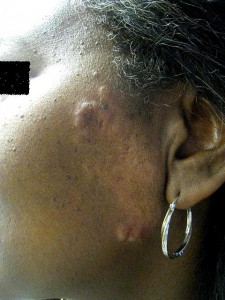Sarcoidosis
Evelyn Lilly, BA and Roopal V. Kundu, MD

Sarcoidosis comes from the Greek word “sarkodes,” which means fleshy. As the name suggests, individuals with sarcoidosis may develop fleshy nodules, or granulomas (bumps under the skin). Sarcoidosis can involve many systems of the body, including the lymph nodes, skin, eyes, liver, heart, and the nervous, musculoskeletal, renal, and endocrine systems. Approximately a third of people with sarcoidosis have involvement of the skin. The skin is easily examined and the finding of granulomas is helpful to the doctor in making a diagnosis.
Sarcoidosis of the skin can have many appearances. For example, sarcoidosis may look like small raised bumps, large raised plaques, or deeper nodules, all of which look very different. Sometimes, they occur in an existing scar, so it appears that the scar is changing. Sarcoidosis may be considered or diagnosed by an associated finding in the skin, such as in erythema nodosum. This is tender pink nodules on the shins. However, having erythema nodosum does not necessarily mean that you have sarcoidosis because erythema nodosum can also be caused by other conditions, such as pregnancy, drugs, or other diseases. Diagnosis of sarcoidosis can be confirmed by a simple skin biopsy.
Whom does sarcoidosis affect?
Sarcoidosis can affect men and women of all races at any age. However,
the disease usually begins between age 20 and 40. It is also three to four times
more common in Blacks. In the United States, the risk of a Black individual
developing sarcoidosis over his or her lifetime is 2.4 percent. The same risk for a
White person is 0.85 percent. Moreover, Black individuals with sarcoidosis often
have more acute and severe disease. The difference in rates and severity of
disease among different races is likely genetic, as researchers have found that
certain genes increase risk of developing sarcoidosis.
What causes sarcoidosis?
Sarcoidosis can affect men and women of all races at any age. However, the disease usually begins between age 20 and 40 years old. It is also three to four times more common in Blacks. In the United States, the risk of a Black individual developing sarcoidosis over his or her lifetime is 2.4 percent. The same risk for a White person is 0.85 percent. Moreover, Black individuals with sarcoidosis often have more acute and severe disease. The difference in rates and severity of disease among different races is likely genetic, as researchers have found that certain genes increase the risk of developing sarcoidosis.
How do I know if I have sarcoidosis?
Because of all the different ways in which sarcoidosis may present, it is a difficult diagnosis to make. New skin lesions are always important for a dermatologist to examine. If you have skin lesions suspicious for sarcoidosis, your dermatologist may take a small piece of it, called a biopsy, to examine under the microscope. If you notice other changes to your body, such as difficulty in breathing or vision changes, please let your doctor know. Your doctor can use other tools, such as x-rays of your chest, to look for lymphadenopathy or lung involvement that may explain your symptoms.
What are the best treatments for sarcoidosis?
Without knowing why sarcoidosis develops, doctors and scientists have not been able to develop a specific treatment for sarcoidosis. Many individuals with sarcoidosis do not need treatment because the granulomas are small or resolve over time. For people who have granulomas that are disfiguring or cause problems such as difficulty breathing, treatments are available. For example, topical steroids may be effective for occasional small lesions on the skin. Topical steroids must be used under a doctor’s guidance as they can cause the skin to become thin. For larger skin lesions, your dermatologist may recommend injection of the lesion with steroids. Some cases are severe enough to require taking steroids by mouth. Symptoms of sarcoidosis usually improve on oral steroids, but one must balance the positive effects steroids have on the disease against the negative side effects such as weight gain, mood changes, and difficulty sleeping. There are other immunosuppressive medications that can be used in more advanced cases of sarcoidosis. These drugs have their own side effects that your doctor will discuss.
Additional Resources
National Library of Medicine
National Heart, Lung, and Blood Institute
References
1.Love PB, Kundu RV. Clinical cases in skin of color medical, oncological and hair disorders, and cosmetic dermatology [Internet]. 2016 [cited 2016 Feb 29]. Available from: http://proxy.lib.uiowa.edu/login?url=http://dx.doi.org/10.1007/978-3-319-23615-5

Cutis Journal
Read published peer-reviewed articles written your by Skin of Color Society members

Did You Know
Skin of color patients comprise the majority in California, New Mexico and Texas…and soon will be the majority in Arizona, Nevada, Georgia, New York and Florida.
By 2042, more than 50% of the US population will have skin of color.




